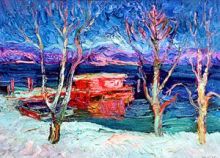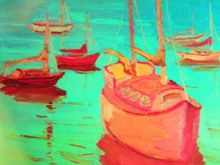In expression of color combinations and richness of subtle color modulations, Nedilko’s paintings can be compared with the best canvases by Mykola Murashko, Fedir Krychevsky, Mykola Hlushchenko, and masterpieces of Paul Gauguin and Vincent van Gogh, Alfred Sisley and Claude Monet.
Mykola Nedilko was born in 1902 in the village of Yushchenovka in Sumy oblast. Sensitive to subtle beauty of nature boy refused to go in the footsteps of his father, who was a doctor, and entered the painting department of the Kyiv Art Institute. Nedilko studied under Fedir Krychevsky and Mykhailo Boichuk. The fact that the two masters were in opposition in their views on art caused a split between the students, who formed irreconcilable camps. Nedilko belonged to a small, neutral-minded group of students, who attended classes of both teachers. And yet, judging from the memories of Nedilko’s fellow students in private conversations he often admired painting of Krychevsky rather than that of Boichuk. All the more interesting is the fact that in 1924 young Nedilko joined the Association of Revolutionary Art of Ukraine, founded by the followers of the innovative ideas of boichukists – the artist Vasyl Sedliar and rector of Kyiv Art Institute, art critic Ivan Vorona.
Short period of participation in group exhibitions significantly helped the young artist to discover his true “self”: he gladly painted landscapes and still lifes, sometimes – portraits, trying to disclose his coloristic talent. Painting focused on the everyday lives of working people was not attractive to him. Therefore, the master sought for rescue on neutral ground – in theater (many “ideologically unreliable” artists of the Soviet era did the same at that time).
After graduating from Kyiv Art Institute in 1928 Nedilko got a job as a scene decorator in the Opera House and worked part-time for several metropolitan studios. His desire to be “in the shadow of theater scenes” was motivated by a desire to engage in “pure art,” searching for interesting compositional solutions, color schemes, harmony and rhythm, and not the party ideology, as was required at that time. “Obviously, Nedilko, focused on color use, was not able to adapt his painting to the requirements of the party-propaganda for realistic rendering of contrived plots. Truly artistic love to barely perceptible shades prevented him from going along the beaten path and toot in fanfare of social realism after graduating from Art Institute,” wrote Bohdan PEVNY. Despite the fact that the artist chose the path of passive resistance, he still had troubles with the “official organs” for many times and once was even arrested.
In the spring of 1929 Nedilko met actress of Kyiv Operetta Oksana Chumak and got a permanent job in the theater of musical comedy and operetta, where he was employed until the early 1940s. When the World War II broke out Nedilko together with Chumak and two fellow painters – Mykola Azovsky and Mykhailo Dmytrenko moved to Lviv.
Painting spring landscapes of Lviv, master revealed himself as a fine lyricist and sensitive colorist. Knowing the charm of nature in the off-season, he often worked in the open air out of the city or in Stryisky Park. Inspired by a series of exhibitions and positive reviews from his colleagues and critics on his canvases, Nedilko dreamed to devote himself fully to his favorite activity. He actively participated in exhibitions in Kyiv and Lviv, showing to the audience his unique expressive style.
However, the artist did not feel free in the Soviet ideology and did not see any prospects for his art work, therefore he was actively searching for an alternative. At one point Nedilko made a decision that turned his life upside down. In 1944 together with his wife he immigrated to Germany and then in a few years he moved to Argentina, and still later he moved to America, where he ended his life. That is why we still do not know a lot about his rich artistic heritage. Meanwhile, American collectors purchase small canvases of this bold colorist for big money at auctions.
Spring of 1979 was the last for the talented Ukrainian artist. Association of Ukrainian Artists organized a post-mortem exhibition in New York, presenting the best works of the master. Today Nedilko’s canvases are very rare.








